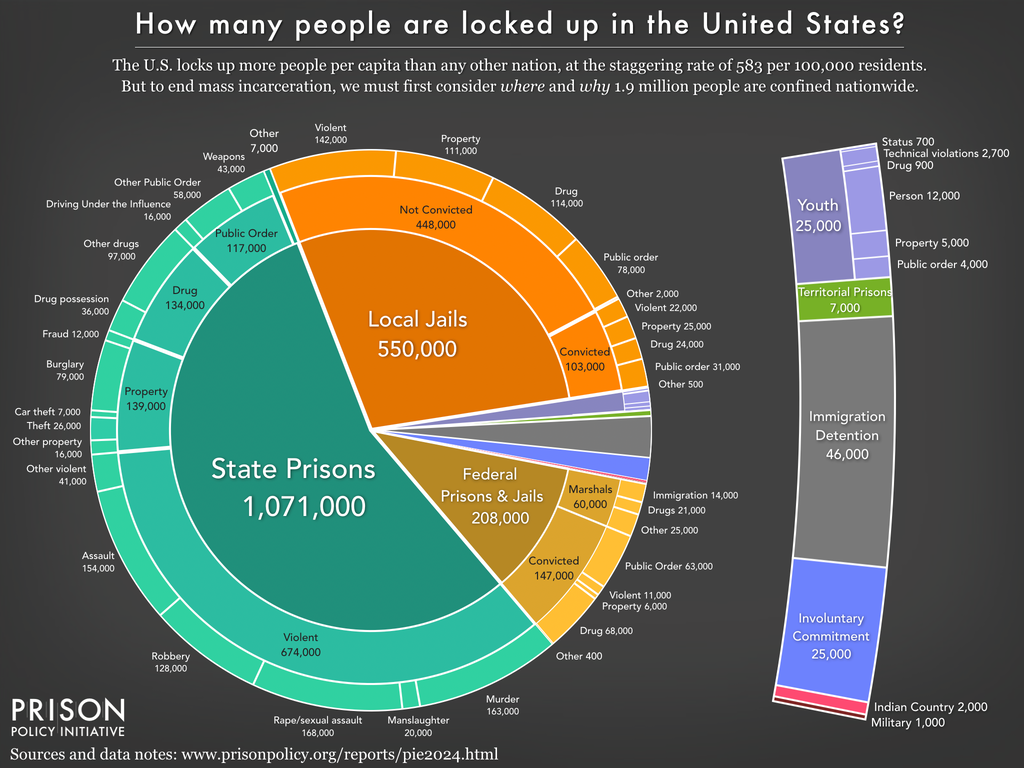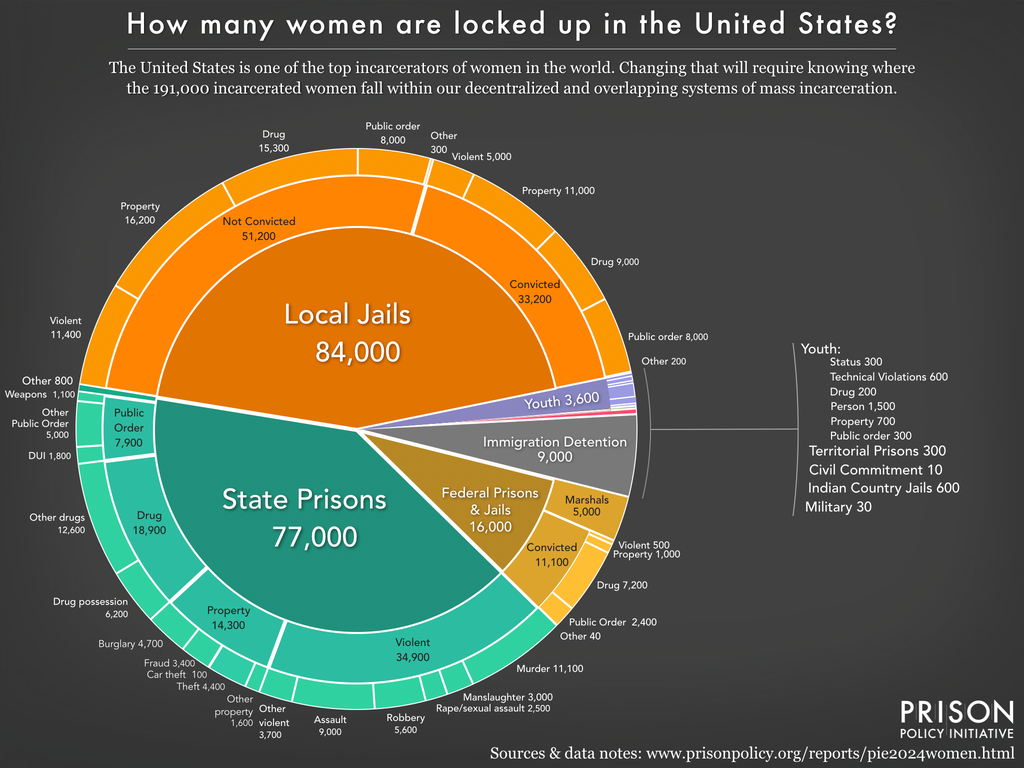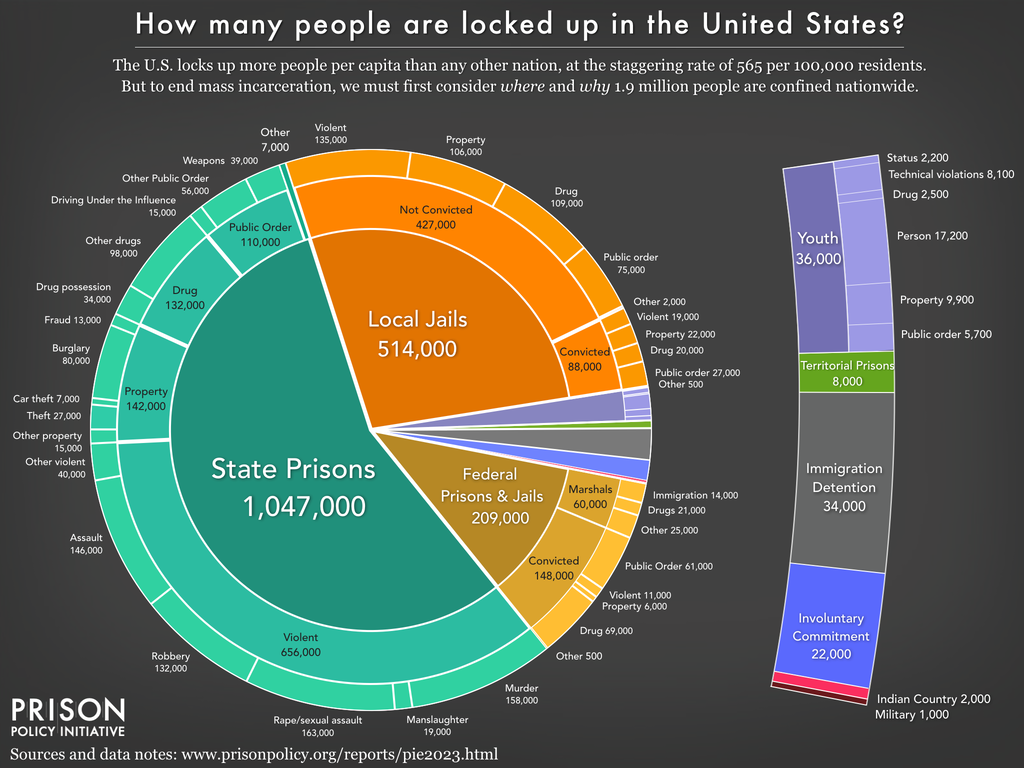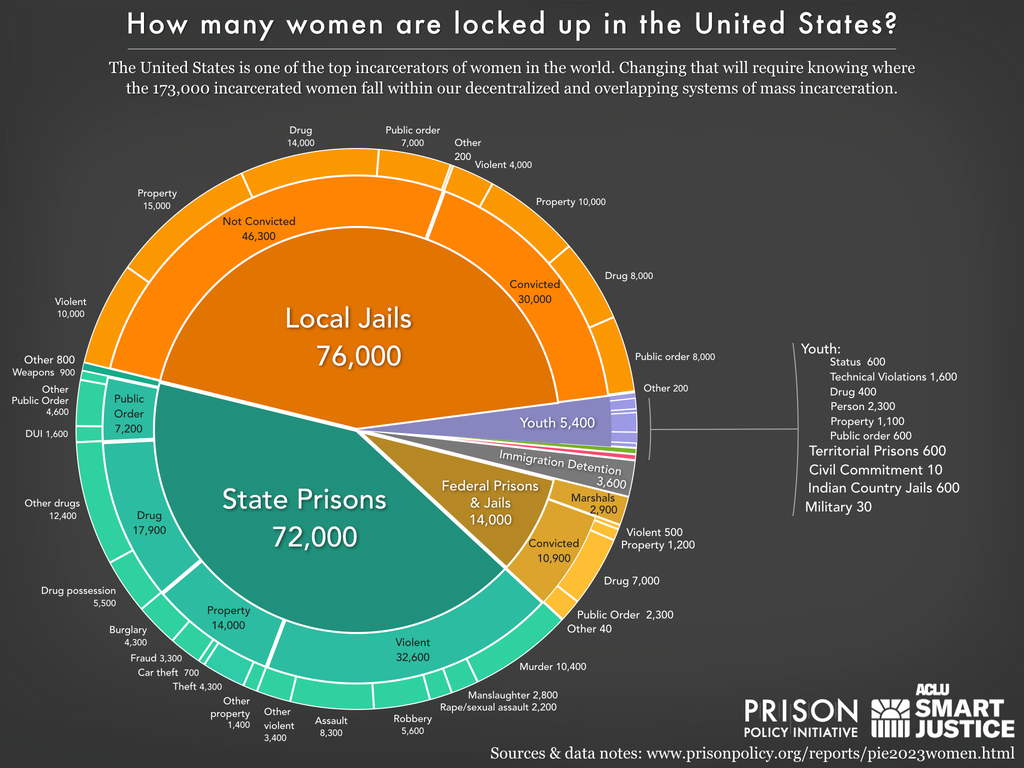12 of our most important reports, briefings, and wins from 2024
From a deep dive into exploitative “Inmate Welfare Funds” to a major phone justice victory, here are some of the highlights of our work from 2024.
by Regan Huston, December 18, 2024
2024 was a busy year for the Prison Policy Initiative. We exposed how prisons and jails are exploiting incarcerated people and their families for millions of dollars each year, highlighted how cruel abortion restrictions affect women throughout the carceral system, saw a major victory for phone justice, and so much more. We curated some of our most important pieces from the last 12 months.
Mass Incarceration: The Whole Pie
This year was the tenth anniversary of our flagship report, Mass Incarceration: The Whole Pie. It provides the most comprehensive view of how many people are locked up in the U.S., in what kinds of facilities, and why. In addition to showing that more than 1.9 million people are behind bars on any given day in the U.S., it uses 34 visualizations of criminal legal system data to bust 10 of the most persistent myths about prisons, jails, crime, and more.
Recognizing that women in the U.S. experience a dramatically different criminal legal system than men do, but data on their experiences is difficult to find and put into context, we released a new edition of Women’s Mass Incarceration: The Whole Pie. This report fills this gap with richly-annotated data visualizations about women behind bars.
States of Incarceration: The Global Context 2024
The U.S. has the highest incarceration rate of any independent democracy on earth — worse, every single state incarcerates more people per capita than most nations. In the global context, even “progressive” U.S. states like New York and Massachusetts appear as extreme as Louisiana and Mississippi in their use of prisons and jails.
Our report examines the incarceration rates of every U.S. state and territory alongside those of the other nations of the world. Looking at each state in the global context reveals that, in every part of the country, incarceration is out of step with the rest of the world.

Shadow Budgets: How mass incarceration steals from the poor to give to the prison
Prisons and jails generate billions of dollars each year by charging incarcerated people and their communities steep prices for phone calls, video calls, e-messaging, money transfers, and commissary purchases. A lot of that money goes back to corrections agencies in the form of kickbacks. But what happens to it from there?
Our report analyzes how prisons and jails funnel money from incarcerated people and their families into “Inmate Welfare Funds” — and then use it to cover the costs of incarceration.

One Size Fits None: How ‘standard conditions’ of probation set people up to fail
More than 1 in 10 people admitted to state prisons every year have committed no new crime, but have simply broken one or more of the many conditions, or rules, of their probation. Our report provides one of the most comprehensive 50-state compilations of “standard” conditions of probation to date, shining a light on the burdensome rules that govern the lives of nearly 3 million people and that doom many to inevitable further punishments.
Two years after the end of Roe v. Wade, most women on probation and parole have to ask permission to travel for abortion care
To understand how the overturn of Roe impacts women under the U.S.’ massive system of community supervision, we examined standard supervision conditions in each state, along with the number of women who must comply with them. We found that the one-two punch of abortion and supervision restrictions impacts an estimated 4 out of 5 women(82%) on probation or parole nationwide. That means that for the vast majority of people under community supervision, the ability to seek abortion care out-of-state is left not to the pregnant person, but to the discretion of a correctional authority, typically their probation or parole officer.
Donald Trump can still be president, but he could be barred from being a bartender, care salesman — or real estate developer
Donald Trump’s legal proceedings would not have stopped him from being president and most likely won’t create many obstacles that a billionaire can’t handle. But there are still more than 19 million people in the US with felony convictions that face hiring discrimination for ordinary jobs every single day. In this briefing, we explain how states can end removed barriers that prevent people with felony convictions from securing good jobs.
10 ways that mass incarceration is an engine of economic injustice
In this briefing, we compile ten examples of how mass incarceration blocks progress toward economic justice. We argue that our massive system of criminalization is not an isolated issue, nor is it someone else’s problem; it is an engine of inequality that traps people in poverty, weakens worker power, and undermines political organizing toward a more prosperous future for the vast majority of people.

Since you asked: How many women and men are released from each state’s prisons and jails every year?
Journalists, advocates, and other users of our website reach out frequently to ask if we know the total number of people released from prisons and jails in their state each year. Many are trying to fight for more resources for people returning home and want to know how these numbers break down by sex. While these are numbers you might expect would be easy to find, they aren’t published regularly in annual reports on prison and jail populations by the Bureau of Justice Statistics (BJS). To make this information more accessible, we’ve drilled down into the most recent data available to show how many men and women are released from prisons and jails each year.
Addicted to punishment: Jails and prisons punish drug use far more than they treat it
Jails and prisons are often described as de facto mental health and substance abuse treatment providers, and corrections officials increasingly frame their missions around offering healthcare. But the reality is quite the opposite: people with serious health needs are warehoused with severely inadequate healthcare and limited treatment options. This briefing builds on our past work about the unmet health needs of incarcerated people and the endless cycle of arrest for people who use drugs by compiling data on treatment availability versus drug-related punishment in jails and prisons across the country. We find that despite the lofty rhetoric, corrections officials punish people who use drugs far more than they provide them with healthcare.
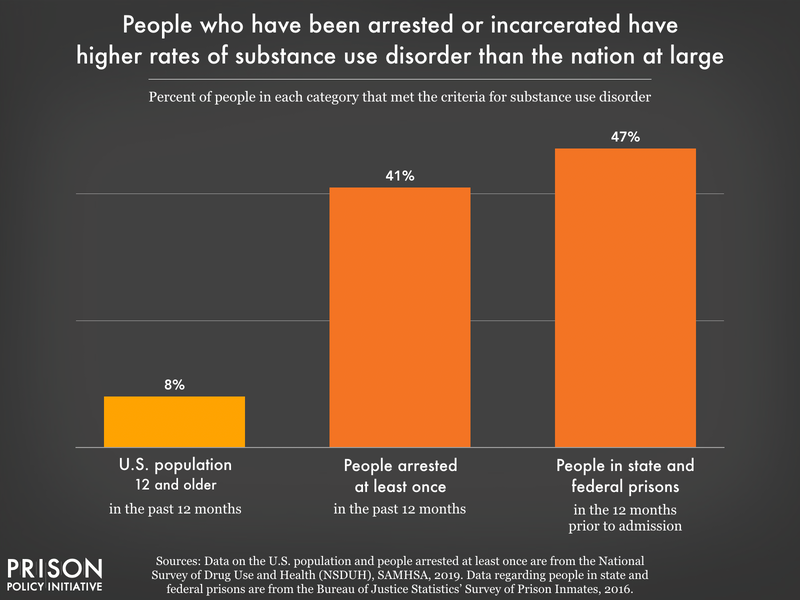
FCC votes to slash prison and jail calling rates and ban corporate kickbacks
The Federal Communications Commission voted to implement several new regulations on phone and video calling services in prisons and jails. As required by the 2022 Martha Wright-Reed Fair and Just Communications Act, the FCC laid out new price caps that prisons, jails, and their telecom providers must abide by, significantly lowering the existing caps which were set in 2021. The agency also made a number of long-sought reforms that will bring critical relief to families of incarcerated people and reduce incentives for bad policy in prisons and jails.
Minnesota ends prison gerrymandering
This year, Minnesota joined the rapidly growing list of states that have taken action against prison gerrymandering. The measure requires state and local governments to count incarcerated people at their home addresses when drawing new political districts during their redistricting process. This is a huge win and yet another reason for the Census Bureau to finally change how it counts incarcerated people and end prison gerrymandering nationwide.

Prison Policy Initiative support helps Fulton County advocates stop massive jail expansion
At the request of the Georgia-based Community Over Cages Coalition, the Prison Policy Initiative examined the proposal for a new jail and found serious shortcomings. In a 17-page memo, we explained how the overuse of pretrial incarceration hurts communities, the feasibility study the county commissioned failed to consider alternatives to new jail construction, and it also ignored that a massive new jail would exacerbate existing staffing issues. Less than one month after the release of our findings, the Fulton County Board of Commissioners voted to scrap its $2 billion plan, marking a major victory for advocates.
If your community is considering building a new jail or expanding the capacity of its existing facility, we may be able to help you push back. Drop us a line to tell us about your fight.
This collection of work only scratches the surface of what we accomplished in 2024 — and our work is far from over. Next year, we’ll continue to expose the ways that mass incarceration harms people on both sides of the bars and highlight solutions that keep communities safe without expanding prisons, jails, and the carceral system.
